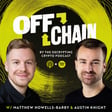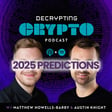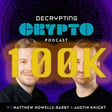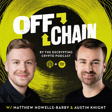Become a Creator today!Start creating today - Share your story with the world!
Start for free
00:00:00
00:00:01

Explaining the Current Market Volatility
In this week's episode we break down the major drivers of volatility in global markets. We unpack what's causing the major drawdown in the Nikkei, S&P500, NASDAQ, and many other major global indices, plus the bleed in crypto markets. Plus, we take a look at one bright spot: the ETH & BTC ETF flows.
Transcript
Welcome Back and Market Overview
00:00:12
Speaker
Alan, welcome to the Decrypting Crypto Podcast. It's August 8th, 2024, and this is off chain. Your weekly recap of the biggest stories in the crypto space. After a couple of weeks that we've been ah we've been out, we thought we'd wait for the most active week to jump back in with another episode. And I'm Matthew House Barbie. And as always, I'm here with Austin Knight. How's the past few weeks been, Austin?
00:00:35
Speaker
Wow, what a roller coaster ride, Matt, my goodness. Yeah, a few things have happened. um If any of our listeners here have even remotely been paying attention to the markets, you'll have noticed that it's been quite volatile out there. And what we are planning to do in today's episode is have a little bit of an update on the state of the market.
00:01:00
Speaker
can share our perspectives, but more importantly, take as much as possible an objective look as to what's happened and some of the inputs to the current kind of state of the the market. And then we can ah share our opinion on where it goes from from here. So we'll jump straight in.
Market Sell-Offs and Historical Context
00:01:30
Speaker
Okay, so what happened? A lot happened is the answer. ah So let's let's go back to Monday because you know there was a lot of rumbling, especially in crypto, that was happening over the weekend. um Quite a sell off that happened from late Friday through to Sunday. And then Monday, you could kind of see this being built up in the futures market um on the S and&P and most importantly, the Japanese Nikai index.
00:02:02
Speaker
And once the markets opened, it was an absolute bloodbath. um So the Japanese Nikkei index, which is you know the the large index of stocks on the Japanese stock market, ah fell 12.4% in a single day.
00:02:19
Speaker
And that marked the biggest one-day sell-off since 1987, which is when they had the Black Monday crash. So that is extremely significant. 12.4% for a major industry is almost unheard of. And when you put into perspective the S and&P 500 in the US market, US index,
00:02:42
Speaker
also was a bloodbath and that dropped 3%. So the context of blood baths we're talking about here. The NASDAQ similarly fell 3.4% on the day in the Russell 2000, which if you're not that familiar with the Russell 2000, you think about that as like the small cap stocks. Smaller businesses and there's a much bigger measure of um I don't want to necessarily say local businesses because they're still public companies, but um they are much smaller market cap companies. That declined 3.3% and pretty much wiped out all of the gains that it had made for the year. S and&P, NASDAQ, and even the Nikai is still actually up year to date, mainly because they've all been on the tear, but things are looking far less rosy in Japan. We're going to come on to that. What else happened?
Yield Curve and Crypto Market Impact
00:03:30
Speaker
I think most notably in the bond market in the US, the US s Treasury yield curve came extremely close within a few bits of re-inverting. So the the yield of the two-year becoming less than the yield of the 10-year. Since kind of Monday, it's now kind of that that That gap's widened back again and we're back to kind of where we've been for the past couple of years at least, um but something to pay close attention to. And then coming into the crypto markets,
00:04:06
Speaker
Monday alone wiped out over $3 million dollars sorry in total crypto market caps. So quite quite a lot. Bitcoin dropped 15%. ETH dropped 22% on the day. Lots of pain, lots of red numbers um on the Monday.
00:04:27
Speaker
so One of the standout kind of metrics that people have been quoting quite a lot is the the VIX index. And you may not be so familiar with it, but Monday morning, um the the peak at least on Monday morning was the highest level that the VIX has hit since March 2020. And I hate to bring your memory back to March 2020, but that's when we had that massive crash off the back of the the COVID pandemic.
Volatility Indices and Platform Outages
00:04:58
Speaker
Now, let me just explain what the VIX is real real quick. um You'll, you'll hear it often referred to as the fear gauge. And this largely, it's an index that actually is tradable, sometimes used for um kind of hedging against market volatility, but
00:05:16
Speaker
to To dumb this down a little bit here, this is just a an index that reflects the and investor's expectations for volatility over the next kind of one month or 30 days.
00:05:30
Speaker
in either direction. So if the VIX index score is high, then traders are expecting huge amounts of volatility, either to the upside or the downside in in stock markets. So it's usually kind of like a bit of a bellwether that that traders will use. so Now the ah COVID pandemic, it hit 85.47. That was absolutely enormous. and if you kind of bring your hazy brain back to that time, if you remember what was going on in the stock market, it was a seriously big red day in the markets.
00:06:05
Speaker
Now, for the majority of this year, VIX has been kind of around the 13 to 15 mark, which actually is extremely low and out of the ordinary. So it's like two extremes here. On Monday, it peaked to 65.7. That is a very sharp rise. um So when we see the VIX spiking like that, we see a ton of volatility.
00:06:32
Speaker
so Lots of things happening on Monday. The classic turnaround Tuesday happened, which is the the phenomenon of, I think, overselling happening and people um buying the dip and it rebalancing, but we were still down pretty significantly. And we still are down week over week, even though we've kind of pared back some of the but losses.
00:07:01
Speaker
So that's what we are. You see, Matt, like on on Monday, um how many trading platforms either went down entirely or or were having performance issues? Like once again, Robinhood, Charles Schwab. I even saw reports of TD Ameritrade, Fidelity, E-Trade. VanEck, I think. yeahp Yeah. What's the deal there? like Are they legitimately overwhelmed? there's There were a lot of people saying that there there were attempts to keep consumer traders or retail traders out of the market during that time. Do you have any thoughts on that?
00:07:39
Speaker
Yeah, i have i have strong I do not buy the keeping retail traders out of the market. It's how these platforms make money. And in a high volatility day, it's important to remember, right, if you are a ah brokerage, um volatility is what you care the most about.
00:08:01
Speaker
it's It's far less important from a ah the perspective of if things are going up or down. That's about ah about momentum. High volatility days, you're going to make money right because volume will be highly linked to to volatility. Here's what I think is interesting. so First of all, just to cover that off, I believe that they all legit went down due to demand.
00:08:25
Speaker
It's incredible. I know, right? But here's here's something that I think is is a sign of the current market. I think we've reached a new stage in the cycle, in the current market cycle, not just crypto market. I'm talking about like the current macro cycle where... I don't really know how to put this, but it's like,
00:08:53
Speaker
Bad news is bad news, and good news is good news. So like actually, like the markets are trading on good news, and the markets are trading on bad news. And we've had a lot more bad news. this this We're starting to see a lot more volatility. But here's what's the dynamic that I think is worth noting.
00:09:12
Speaker
If we go back to March and we had, I believe it was March when we had, um, roaring Kitty come back in and we had the game stock, like meme stock squeeze happening. I mean, that already feels like a lifetime ago, right? But.
00:09:29
Speaker
volatility spike. GameStop was one of the cases where I think Robinhood did intentionally pull trading, right? I think that's actually like the source of all of people's skepticism around what was happening on Tuesday with this across all of these platforms, yeah on Monday rather. Yeah, I think so. And, um, but here's, here's what I think is interesting though, right? Like during that massive upswing in, in price, like price appreciation where we were having some momentum in the market.
00:09:58
Speaker
None of these platforms are going down. ah In the downturn, they're all going down, which tells me that risk appetite, if we had to just take a little step back and say like, what is the risk appetite around like momentum trades right now? And I think that on the retail side of things in particular,
00:10:19
Speaker
people are looking for reasons to sell versus looking for reasons to buy. um So you know like with anything when it comes to macro, we're reading between the lines of a lot of things, but I do think that that is a small but significant thing to think about.
00:10:36
Speaker
um I mean, that makes sense, right? Like, you may more sober minded, even if something is on a ah sharp upswing, you you may still more sober mindedly buy into it. Also, it's going to take longer time for that news to get around. Because if I don't own GameStop stock, you know, I could find out on Friday, I could find out on the following Monday, it's all a matter of whether or not I'm checking the subreddit, right? But If I do own GameStop stock, I'm tracking that stock on my phone. Maybe I'm in ah you know a Discord or a Telegram channel. Maybe I'm regularly checking the subreddit because now I have a ah staked interest in it. And so as soon as the negative news goes around, I could see the sell-off just by virtue of that happening at a faster rate and being more likely to overwhelm systems. right
00:11:34
Speaker
Yeah, for sure.
Investment Shifts Due to Interest Rates
00:11:35
Speaker
I also think, you know, there' there's another extremely important dynamic at play in all of this that is going to change pretty soon, which which is actually, I'm almost like skipping ahead a little bit here, but like one of the reasons why I'm a bit more positive about the medium to long-term. If you think about um decide Let's take equities as an example. ah Crypto is the exact same story falls into the same bucket of what people would call like, you know, quote unquote, risk assets.
00:12:10
Speaker
um Making the case to buy tech stocks, for example, or crypto, the decision you're making is that you believe that you can get outsized returns on your investments by parking your capital in equities or crypto versus an alternative, right?
00:12:31
Speaker
And we are still, it's easy to forget, and in an incredibly high rate environment. When you're in an incredibly high rate environment, the yield on your cash is extremely high. So the alternative to, or at least like the spread between the the potential upside of just holding in cash versus the potential upside in um investing in equities,
00:12:56
Speaker
is much tighter. And so when you also layer in the risk, right, so we we look at things like US money markets, which, if you're not super familiar, US money markets are effectively like institutional kind of grade savings accounts, and they track at a variable rate, the um a a return based on the the bank rate, or at least like largely across like central bank interest rate.
00:13:22
Speaker
So its rates are high, you're getting a really nice return on your your cash, you can pull that cash out. um at any time. So US money markets, coincidentally, ah have all time highs of assets under management. like In Q1, we're still waiting on additional numbers. But in Q1, total assets held in money market funds in the US passed $6 billion. In 2020, this was just below $5 billion. So there's an additional $1 billion in in assets. And you go back a few more years, and it's like you know half that number.
00:13:56
Speaker
so It's, there are so many nice safe pays and havens to go into, even like, you know, going into the into the bond market, which is what we saw a huge flood to on Monday. And hence why the spread between the two year and the 10 year got compressed so much. So when we think about this as like, okay, how easy is it for me to exit my position?
00:14:28
Speaker
into a much safer, stable asset, lower risk with still attractive yields. Today, I mean, it's like perfect, it's great. Like, you know, you're even just remotely worried about volatility in the stock market. You just move capital out into either money market or into the bond market and then wait, and then you you you can reenter. As yields start to come down, and sorry,
00:14:55
Speaker
as the interest rates start to come down set by the Fed. Well, the the yield um on cash is going to reduce pretty significantly. So that safe haven has become less attractive and the appetite for risk will increase. it's So I think there's like ah ah bit of um there's not a whole lot of stickiness in risk assets as a result. And I think that for me is like one of the biggest reasons why we're we're seeing so many jitters on pretty much any bit of bad news today because
00:15:29
Speaker
pretty pretty nice place to be to just move things out and still be able to get you know four or five plus percent um APR on your cash. That's yeah pretty nice, right? yeah So why why don't we talk to some of the reasons behind the the crash that happened on Monday and what's kind of happening right now. And I think point I want to make the the caveat in all of this in that it is not any one thing, like is always the case and in in macroeconomics, right? It's often a confluence of factors, some of which are structural, and then there is just the psychological aspect that that comes off the back of them. But without doubt, you know I would say there's two big pieces that's that's happened as a result for for what's driving this. First,
00:16:26
Speaker
The yen carry trade, we're going to come into this. It's been talked about a lot in the economic press. in so So we can dig in and give you the very brief TLDR on that. Japan being a big source of the volatility that's come. And then we have the US economy, which we talk about a lot more. And there was a string of concerning data that's come from there.
Global Impact of Yen Carry Trade
00:16:52
Speaker
Let's start with the yen carry trade.
00:16:54
Speaker
so
00:16:56
Speaker
but's just ah Let's just talk about Japan for a moment because what's what's really, if if you're not super familiar with the Japanese economy, it it plays a huge role in the US economy and the global economy for a number of reasons. And one of those reasons in particular is that the last time that Japan's bank rate, that their interest rate, right, has been above 10 bits, which is 0.1 of a percent.
00:17:25
Speaker
was at the end of 2008. And for the most of the time since then, the rate has either been at zero or it's being negative, right? so So just think about that for for a moment, right? Most of the time they've been in negative interest rates since 2008. And they have yield car controls and a whole other load of stuff that um enables this, but that's to one side.
00:17:50
Speaker
So knowing that, the cost of borrowing yen is extremely low. right um And in a negative interest rate sense, it pays to do that, which you know is a bit of a mindfuck to think about, but let's just park that one as well. So the yen carry trade is a very popular trade and a very you know crowded trade.
00:18:11
Speaker
And when these things go bad in very crowded popular trades, there's a huge ripple effect of the outcomes of this. But it involves borrowing yen, um which is extremely cheap, as I just said, converting that yen into another currency, for example, USD.
00:18:32
Speaker
and then investing those thought funds in higher yielding assets. So this could be like T-bills, US equities. I mean, it could be, you know, equities in um Latin, UK, et cetera. And ah the profit that you're making comes from the interest rate differential, right? So for example, you are, it's extremely cheap to borrow yen. You are then converting the yen you've borrowed into USD.
00:19:00
Speaker
you're putting that into T-bills and getting like a four, 5% yield, and you're able to pay off ah the the yen debt at still a much cheaper rate than the yield you're accruing in the other assets. So this is this has remained a very popular trade because the Bank of Japan doesn't mess around with interest rates very often and is extremely dovish when it comes to interest rates.
00:19:30
Speaker
That was until last week. So and inflation has been hitting Japan and the Bank of Japan decided to increase its interest rate. We anticipated that this was going to happen and people thought that it was going to go up by 10 bits, so 0.1%.
00:19:50
Speaker
they decided to surprise the market with a 0.25, so a 25 bits increase um in in the in the interest rate, which caught everyone off guard. As a result, the the value of the yen compared to other major currencies, including the US, increased.
00:20:14
Speaker
which made the carry trade less attractive ah because the the margins are much tighter now. So if you've borrowed yen, sold that for USD, and then you need to repay that and amount of yen by converting back your USD into yen. Now, the problem happens is when the exchange rate of yen increases, the rate that you're gonna get for converting back your USD worsens. So now you need to make up that that margin a little bit more, which means it's coming out of your profit. And there's the worry that you know you could be kind of caught out at sea with your pants down. And um as a result, and I think in particular, the commentary from the BOJ, which seemed very hawkish, has meant
00:21:06
Speaker
that a huge amount of unwinding was happening in this carry trade. And that effectively means that people are completely unwinding all of their sales, all of the Nikkei index that had had a huge sell-off, largely a big chunk of that coming from the Japan carry trade being unwound so that ah investors can reposition themselves. and This bled over into the US stock market.
00:21:33
Speaker
bond market, hence why and we saw such volatility in the T-bell yield. So all of this kind of coming has a huge ripple effect into the global economy, in particular the US, but obviously Japan. So that's why we're talking about Japan.
Economic Indicators and Recession Signs
00:21:52
Speaker
And then comes the second piece. So then we have the US economy. And me and you talk a lot about this, Austin, right? so yeah may You may have seen some of this, I'm not sure if you're familiar with the Saam rule, but it's been now all of a sudden talked about a ton. um And the reason why is because the Saam rule named after Claudia Saam was triggered last Friday. What does that mean? Well, the Saam rule is basically, it is an economic measure used to identify the early onset of a recession.
00:22:32
Speaker
Now we've been talking for quite a long time, Austin, about the soft wine thing, right? And all of a sudden- I didn't believe it for a single day. Yep. And in fairness, yeah, you you mentioned that. and And I think the ah consensus in the market has changed a lot. So the rule behind the song rule, right, it it says that A recession is likely when you take the three month moving average. So we look at unemployment rate rises. So take the three month moving average of US unemployment rates by when it rises by 0.5 percentage points or more.
00:23:14
Speaker
relative to the low point of the prior 12 months. That's when the SAM role is triggered, and that's when the SAM role suggests, never mind, right? This is not causal, this is just correlation, right? It suggests that we're at the start of a recession. On Friday, the US job report came in much lower than expected. So unemployment was at 114k. It was 179k in June.
00:23:42
Speaker
ah Unemployment rates rose from 4.3% from 4.1%. Why do we care so much about unemployment rates? Why do we think about this? Well, Unemployment rates are a big kind of correlative data point to wage inflation. When unemployment rates are lower, we assume that there are more jobs on the market, more people are getting hired with a greater turnover and new jobs on the market.
00:24:12
Speaker
that is and ah That often results in higher wage growth because with new roles being offered, higher salaries, more competitive um employment marketplace, greater wages being offered, which leads to higher inflation, et cetera, et cetera, the inverse is happening by much more than expected, right? So we thought it was going to be 4.1% and it came in at 4.3%.
00:24:33
Speaker
The July figure brings the average unemployment rate of the past three months to 4.13% and the previous low from 12 months was 3.5%. So it had to just, if it increases by 50 bits, 0.5% on that 3.5% number, the Saan rules trigger. So we're just over it, right? um So it's like 0.63%.
00:25:00
Speaker
Claudia Simon's been on a bit of a roadshow talking about this. It's interesting you should listen to some of the stuff that she's been saying where I think she's actually been saying she's not 100% sure if this truly is showing a recession. But that doesn't matter because everyone's panicking. And this has kind of sparked fears that the Fed is behind the curve in reducing interest rates because last week they decided not to raise rates and ah it seems like the US economy is in far worse shape than inspected, triggers a recession, then we've also had lower than expected earnings calls from
00:25:40
Speaker
pretty much all of tech. That's less worrying than what's probably going to be coming. I think next week we've got Walmart and Target and a few other of the big retail consumer driven companies that are again big retail consumer health bellwethers that we pay attention to.
00:26:02
Speaker
And all of this comes to say, this has changed the narrative on rate cuts pretty dramatically. So we've been talking, Austin, about how we rate cuts are going to be really bullish for the market, right because you know rates come down, the cost of borrowing goes down, more capital and liquidity comes into the market, risk assets are on, everything goes up.
00:26:28
Speaker
That's right when you assume that the Fed is ahead of the curve and that they are preemptively rate ah like ah reducing rates and that we're going to have a soft landing. It changes a lot when you feel like they're behind the curve and now they're having to scramble and the recession is going to hit worse than than we thought, or that there is going to be a recession. So it's going to be really interesting. I think that, I don't know about you, Austin, but um I mean, September rate cut is basically locked in now. The question and what I think has been really interesting is the calls for a 50 basis point, um, uh, rate cut in September. I'm unsure, but if we get some bad news by kind of like the, uh, the start of September, who knows?
00:27:16
Speaker
Yeah. You know, here's the thing. um Investors, institutions, rich people, people with money that are in the markets are always pressuring the Fed for a rate cut.
00:27:29
Speaker
ah because that's how they get rich. They effectively export their inflation to the net contributor class that is not in the market. Because when we cut rates, we print money, and that decreases the value of the dollar. But if you're in the market, you can outpace that. And that's why and you know during the COVID period, um we we saw incredible ah wealth transfers happening. It may not have been so explicit, but it did happen. The wealthy got wealthier. um And the middle class bore a huge brunt ah along with the poor of the cost of inflation. Why did inflation happen? Because we printed an unprecedented, ungodly amount of money, something like 80% of US dollars in circulation. And by the way, that was after
00:28:24
Speaker
over a decade of zero interest rate policy. okay if you're If you're an average person living in the US, living in Europe, living in Japan, and you feel like you've felt inflation, it is the result of this policy this type of policy. And what makes me nervous is that you know if you look around you right now at home values, just as an example,
00:28:51
Speaker
um Most likely say that if you're in the US, I would wager that you're you're you're probably looking at homes around you being still maybe 20, 30% plus a higher asking price than they were in 2019. And in 2019, everybody was complaining about the huge run-up that happened.
00:29:14
Speaker
ah since like 2013, 2014 on real estate values. And it seemed like real estate values were really high at the time and were on the precipice of crashing or something like that because it felt unsustainable. And then we went to what was ah really an effective negative interest rate policy, because for example, I have a 2.75% interest rate on my home, I think, but inflation ah You know, on paper was somewhere in the neighborhood neighborhood of like five to 7%, maybe like real inflation was higher than that, like something like 12% annually. It's hard to get an exact number on that. You know, there's the government data, but that's manipulated. But anyway, no matter what you take 2.75 and, uh, you know, take that out of say 5% or 7%. And.
00:30:03
Speaker
Effectively, you're being paid like four, five, six, depending on how you cut it percent to, uh, to have a mortgage because you're basically avoiding that inflation with your 30 year fixed rate mortgage.
Rate Cuts, Inflation, and Wealth Disparity
00:30:18
Speaker
Right. So what this does is, uh,
00:30:21
Speaker
You know, people people that have any form of an investment. I mean, for some reason, homes are considered investments, but there are many other forms of investments as well um that, ah you know, they they shield you from that inflation. And then at least on paper, they go up in value. ah Folks that aren't participating in that don't don't get that benefit. And what makes me nervous about this is that because that inflation hasn't been worked out of, real estate worked out of the market yet, you can still see it in home values. You can still see it in the market, as you said, like the market is higher today than it was at the beginning of the year, even after this you know panic period. And you can certainly ah see it in consumable goods.
00:31:11
Speaker
um The fact that we're looking at cutting rates again, ah ah to me, you know the the rational behavior that would happen is that this would cause further inflation, or at least ah you know it would put further pressure on your average citizen.
00:31:31
Speaker
hardworking person, ah especially people that are paycheck to paycheck. But what's interesting, Matt, is I think back to 2008, I was really young, but I can remember it pretty distinctly. And um we ah we always talk about like the the global financial crisis that's happening in 2008. But really, if you look at the data, it kind of started in 2006.
00:31:57
Speaker
And it didn't truly, uh, get to the point where it was affecting, affecting your average person until 2008. I mean, that's because these things take time. Right. Um, but and a lot of this stuff is lacking. Right. Yes. I think that the biggest challenge in all of the the data points we have is that we're talking.
00:32:19
Speaker
you know A lot of the discussions around like the data points, jobless claims, unemployment rates, even CPI, or all of this stuff is a lagging indicator to um understanding the true state of the economy and the ah ah the state of the market. and yeah you know I actually have a slightly different perspective on rate cuts. I am actually in the place where I i think we're going to see in the next CPI print that inflation's continue to to cool and as is going to cool pretty significantly.
00:32:56
Speaker
um I think, I agree with like your your take on um if if not done properly, it can exacerbate the wealth gap. I think much more so quantitative easing is a bigger ah player in that. and I think that's what we really saw in 2020. But i i I'm starting to get to the point where I think that the Fed is, they were too slow to raise rates in the first place, which is what made this mess as bad as it is right now.
00:33:24
Speaker
I get the feeling they are starting to fall behind in that their cutting cycle. I personally think that they should have cut rates in a small small amount.
00:33:38
Speaker
this past week and they could have started with a 25% cut and just slowly, steadily come in. And I think what's going to end up happening is they're going to get caught out and they're going to have to do, whether it be September or the next month, much bigger cuts that's going to spook the market.
00:33:57
Speaker
It's going to spook everyone and it's probably going to show that they're behind the curve. And what that means is mortgage rates and otherwise stay high longer. That's exactly correct. Even in the US, I mean, it's looking at mortgage rates and it's like, hooray, they're down to some of their lowest points in years now and it's like 6% on a 30 year. That's a horrible, horrible rate.
00:34:22
Speaker
yeah I actually, I don't disagree with you at all, Matt. um I mean, I don't, you know, i i I am skeptical of rate cuts, almost as a matter of principle, certainly skeptical of anything that that could start to pave the path towards quantitative easing easing yeah rather um you know as opposed to quantitative tightening, which I think is still what we need. we need you know the and Just an incredible amount of money was injected into the economy over the past few years. That bill is going to come due one way or another. And it's going to be cheaper to pay now than it will be 10 or 15
00:34:58
Speaker
years from now, but this is where I was going with 2008. Okay. It really started in 2006, but your average person on the ground started to feel it in 2008. And that's why we referenced 2008. Well, what happened in 2008? A lot happened. And as I said, these things take time.
00:35:14
Speaker
But one of the significant things is that that's when the Fed really started to cut rates in earnest. And in fact, if you look at ah rate cuts in relation to recessions over the the the course of the past several decades, usually some form of an aggressive rate cut did precede a recession. I'm not saying that the rate cut caused the the the recession, but I think that it does have exactly the effect that you just described there, which is that What if the Fed takes an aggressive rate cut? It can spook the market and it's not going to have the ah you know effect that theoretically they may may have intended it to, but it will have the effect that you described, which is that it won't increase inflation. The reason is because everybody is going to be spooked out of spending their money when they start to feel a recession set in.
00:36:07
Speaker
Yeah. And I think that there is going to be a lot of volatility coming up in the in in the next month, i September. If if they they they cut by 50 bits, there'll be a massive market sell-off ah right off the back of that. Pretty much happens anytime when people believe that the Fed is behind the rate curve and they're scrambling and that the recession is going to be worse. So we probably see something there.
00:36:36
Speaker
Um, I think the good news though is, so here's, here's why I'd be positive about the future. It's pretty common for events like this to happen. And you know, I talked about the low risk alternatives to park cash. The friction to getting out of, uh, risk assets is very low right now as rates come down, that will increase. So we should start to see like less. Smaller swings over the next 12, 18 months.
00:37:07
Speaker
The yen carry trade unwinding is temporary. I mean, even today, dollars up against yen, and it's been kind of clawing back. the Importantly, the BOJ, Bank of Japan, has come out with a much more dovish sentiment. So they're saying, hey, don't worry. We're not going to aggressively raise rates anymore. They're calming the market that's taking that. So I think that's kind of another piece.
00:37:29
Speaker
As interest rates fall, you know equities in crypto do become more attractive. Can't get away from that. And actually, we had jobless claims come in today, um which... You talk about like market just responding to any kind of news. I don't think jobless claims are ever truly taken seriously, let alone in summer months when you've got seasonality playing a role, but it's a super noisy metric, but I think we're just clutching at anything right now. And the the the S and&P is up it so far today and ah because they came in lower than expected at 233,000 versus 240,000. So, you know, a 7,000 delta in jobless claims for
00:38:07
Speaker
for July or early stuff as we get August, not not anything that I think we would normally be shouting about. But this just goes to show the volatility right now. People are looking for a reason. And um that that there are some some positive pieces. And in all of this, I think this is why we can kind of come on to the the last point that you want to talk about, Austin, as well, is what has been really interesting from a crypto perspective is watching the ETH, sorry, the ETF flows both from BTC and Ethereum. So why don't we, why don't you take us on a bit of a quick summary of what's been happening there.
00:38:51
Speaker
Ethereum ETFs took in more ETH on Tuesday than on their debut, but importantly, not more cash. This is interesting.
00:39:02
Speaker
so The Ethereum ETF saw nearly 40,700 ETH worth of inflows on Tuesday. That is more ETH than the funds took in on their first day, July 23rd, which saw inflows of just thirty or just over 31,000 ETH, still quite a bit actually. But in US dollar terms, the first day still has the record for inflows at 106 million, whereas Tuesday's inflows amounted to 98 million USD.
00:39:33
Speaker
Why is this? Well, it's simple. It's because ETH has been trading for around $1,000 less than on the day that the ETH ETF trading started. It's recovered a bit from its low, but right now it's around 2.5K. Back on July 23rd, it was around 3.5K. So what that means is you can bring more ETH into the ETFs, but less USD just because of that $1,000 delta.
00:40:01
Speaker
Another thing that I thought was interesting about this though, Matt, is that on three days only, ah excluding launch day and August 6th, were the flows positive with the most significant being 18,157 ETH on August 5th worth nearly $49 million. dollars which is which Which was what day of the week? Monday.
00:40:28
Speaker
You know, this was this was on the the crash day. Interesting. so and And this is actually really, really positive, right? Like, what has that told us about our new institutional investors that have come into the space? By the way, the exact same thing played out in on the BTC ETF.
00:40:46
Speaker
they are buying the dip. They are diamond handing, so to so to speak. There has not been any big sell-offs that's happening here. um And I think that is extremely positive. um You mentioned as well, Austin, the ah the the the amount of days we've had outflows, we talked about this, right? We're expecting it. Grayscale is a big driver of that. um I was actually looking at yesterday's numbers that just kind of came in and there was outflows yesterday, 23.7 million, actually the smallest dollar amount of outflows of any of the daily outflows day um and only from Grayscale. And it's worth pointing out,
00:41:30
Speaker
There has only been outflows from Grayscale. None of the other ECTFs have had any days of outflows. Orbit net inflow is just Grayscale. And we saw that happening at an accelerated pace, I think, because they have like the mini trust and they're trying to get this all front loaded. And ah you know we're not far away from that being depleted.
00:41:53
Speaker
And we saw what happened when grayscale Bitcoin trust outflows stopped. Well, you know we had pretty significant inflows coming in across the board. Yeah, it's true. I think that that's exactly what's happening. Institutional investors are calm. And you can see that as ETH has gone down, as the ETH ETFs have become even more attractive,
00:42:21
Speaker
for the long-term investor, institutional investors are buying the
Institutional Moves in Crypto Market
00:42:26
Speaker
dip. Now, there is one other thing that I wanted to talk about here, Matt, which was that you in our in our last story, you mentioned that as interest rates fall, equities in crypto become more attractive.
00:42:39
Speaker
um which I think is supported by the fact that we are seeing these ETH ETF inflows, especially from institutional investors, right? However, another thing that that a lot of people have been talking about is that it's kind of disappointing that the values of crypto seem to be largely following like the S and&P 500 basically, like when the stock market goes down, the price of Bitcoin and Ethereum go down as well. And it doesn't feel as much like it's a safe haven from, you know, from Fed policy, basically. Yeah, it's I mean, that that's what that's what we're seeing. I think that's going to continue. We talked about this at the end of ah the start of ah last year on the podcast, like, you know, can Bitcoin be the inflation hedge?
00:43:33
Speaker
It hasn't shown to be that. And if we think about the flow of capital and the shift in the, the, the investor base of both Bitcoin and Ethereum with more institutional investors, we are going to see probably more correlation between, um, the, uh, between crypto inequities. I think what we have seen a, um, uh, these two diverge is crypto specific catalysts. Great example of this.
00:44:03
Speaker
In the period of March, when and we saw the BTC like inflows really pick up, we did see a breakaway where crypto was having outsized gains versus the S and P and others. And I think we have like some of those pieces. It's going to be interesting to see when we move into more bullish market conditions and when the cost of capital is, is much lower through lower rates, probably around kind of this time next year, how crypto fares up. But i i my my gut is going to tell me it's still going to be heavily heavily linked to equities because a lot of the indicators that we look for, for what will drive equities up are also the same things that will drive crypto up. So i don't I don't really see this as a problem, um to to be completely honest, but its it is worth calling out. I think they are very much linked in in many ways.
00:45:01
Speaker
Yeah, well, it'll be interesting to see. What happens going forward with the ETFs? I think that the Bitcoin ETF, the Ethereum ETF, both of them have been so cool to watch and to see how much interest there has been in them. Definitely. And I think I'm i'm very excited. Once we get the outflows out of the way in the ETH ETF, I'm really excited to see what what that can do um to ETH price and the kind of inflows that we could see. I still remain really excited about that one. but
00:45:34
Speaker
We'll pay close attention to it. We'll keep tabs on things. We'll ah be keeping a close eye on Japan and hopefully they can get their shit together and stop blowing up the rest of the market for all of us. And we'll touch base today. Exactly. And we'll we'll see where we're at next week. I'll see you then, Austin. Yeah, talk to you then, Matt.
00:46:12
Speaker
The contents of the Decrypting Crypto podcast should not be used and are not intended as investment advice. Please do your own due diligence before making any investment, cryptocurrency or otherwise.




![CBDCs: The [Dark] Future of Money (Part 2 of 2) image](https://media.zencastr.com/cdn-cgi/image/width=112,quality=85/image-files/61fc0461fb20e00040aeb09e/5b9f1396-2a8e-418d-82a0-30fd00969266.jpg)





